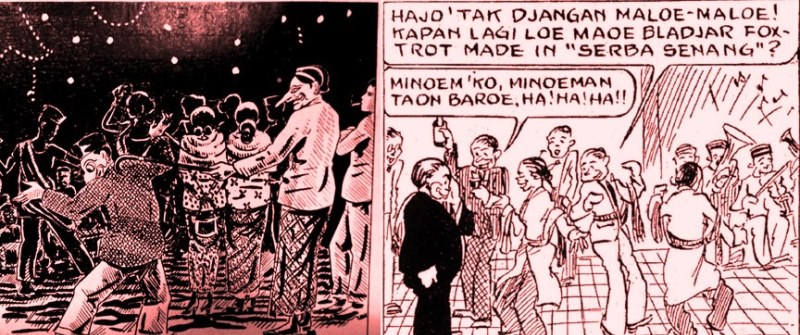
08 Dec Blog: Can you lose your virginity by dancing?
By Tom Hoogervorst
Indonesia made international headlines with its 2006 Anti-Pornography Bill and controversial virginity tests for female military recruits in 2015. The ensuing debate on decency, chastity and the perceived threats to these polarises opinion to this day. Tom Hoogervorst whirls through the Netherlands Indies newspapers to highlight how exactly same concerns were raised a century ago.
Asia’s interwar years brought improvements in education, women’s emancipation and healthcare, but also came with a lavishly marketed popular culture from Hollywood and other faraway places. Any self-respecting colonial era dandy would have readily sold his grandmother to be able to ride a motorcycle, smoke cigarettes and drink beer, whereas his female counterpart – the free-spirited Modern Girl – donned the latest fashion and wore makeup and perfume as if her life depended on it.
As young men and women could now meet at newfangled cinemas, parks, dance clubs and other places away from their ever vigilant parents, a logical and still-relevant question was raised – can you lose your virginity by dancing? Does the foxtrot lead to defloration and the tango to contamination?
Judging from the Sino-Malay newspapers, many writers of those days would have probably answered yes. Modernity is all well and good, but the mostly male journalist establishment had few nice things to say about its new configurations of gender. A 1924 article published in the hugely popular Sin Po – Pergaoelan lelaki dan prampoean (‘The interaction of men and women’) – summarised the ‘problem’ as follows:
“Before she gets married a Western girl has generally had her fill of fooling around, her fill of rubbing her body against tens if not hundreds of men (while dancing!) so that it’s difficult to still consider her truly pure.”
In a 1926 opinion piece titled Samingkin lama samingkin edan (‘The longer the crazier’), published in the same newspaper, one of his colleagues added the following insight:
“They indicate that they really want random men to look at their flesh; that this is really what they want. We just hope that this kind of “civilisation” will not spread to the East.”
These and numerous other Malay writings lay bare several hypocrisies. To many men d’un certain âge, the oft-repeated trope of purity (kesoetjian) reflected their deeply rooted anxieties about social change. It served as a disciplinary framework to ‘protect’ women who sought education, emancipation and freedom to choose their own partner(s). Unsurprisingly, men were typically free to do as they pleased, although their self-proclaimed task to “watch over the girls” must have been a burdensome one indeed.
Fortunately, more progressive voices were also heard. In a 1926 opinion piece titled Bebrapa Katerangan (‘Some clarifications’), published in the newspaper Hoakiao, the Surabaya-born journalist Kwee Hing Tjiat fiercely criticised his fellow men for their double standards on gender, sexuality and traditional values. As he pointed out, his male contemporaries were quick to castigate Asian women ‘polluted’ by Western values as whores (soendel), yet lo and behold… their unbridled joy at the sight of bare-chested girls during a trip to Bali! And as for their fear of modern dancing, it was little more than the fear of common village folks after seeing a car for the first time…
So where have these discussions brought us? Well, dancing is rarely included in today’s lists of activities that can destroy one’s virginity. Still on most lists and due for removal are- – stretching, swimming, cycling, horse-riding and gymnastics…
(Tom Hoogervorst focuses on language contact and Malay linguistics. He is currently studying the development of the (Indonesian) Malay language through the KITLV’s collection of Sino-Malay literature, while simultaneously attempting to cast a new light on cultural contact, the introduction of new concepts and the role of popular culture during late 19th and early 20th centuries.)




No Comments